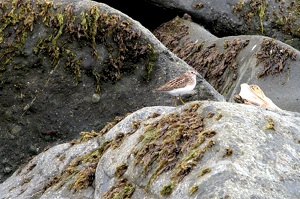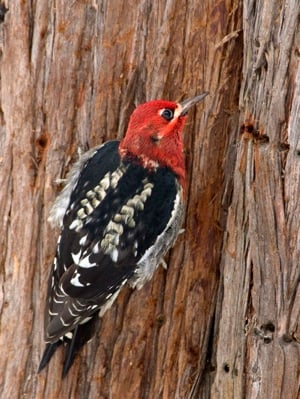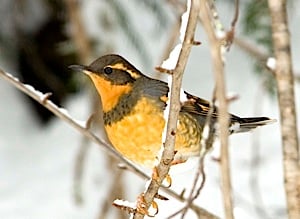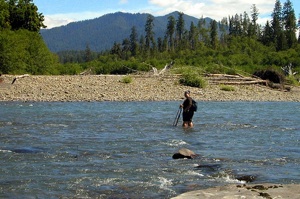This edition of Birding in the National Parks will appear on Valentine’s Day, but despite a week of brainstorming, I cannot come up with a romantic theme for birding in the parks. I could talk about how many birds mate for life (which is often more myth than fact) or how ducks court and mate (which would get most of them arrested if they were people), but none of that seems appropriate.
I suppose I’ll fall back on a question asked here last week: What is the Most Romantic Place in the National Park System? I may be a bit biased, but my wife and I took our belated honeymoon to Olympic National Park in 2008. We went for the fern-studded waterfalls, the moss-draped cathedrals of big-leaf maples, the haunting sea stacks, and the breathtaking views of the Olympic peaks. What we found, among all of those, was the first fuel for a torrid love affair with bird-watching.

Least Sandpipers often can be spotted on algae-covered rocks. Kirby Adams photo.
Most of the big parks sport a range of habitats that accommodate various groups of birds and other animals, but Olympic National Park takes it to the extreme. Base yourself in Port Angeles with three days to kill. The first thing you should do is weep that you have only three days, but once you compose yourself you’re going to go seabird and shorebird watching one day, rainforest birding the next, and birding above the tree-line the third. Three days, three very unique birding destinations, and you’ll be back each evening for a pepperoni pie at Gordy’s Pizza and Pasta. (There are other choices, but birding brings out the Italian in me.)
The beaches of Olympic are renowned for their scenery and their tidepools. But between gawking at the improbable monolithic sea stacks and poking at starfish in the pools at Rialto Beach, we spotted more than a few birds. Sandpipers and gulls were the most numerous, as expected. As luck would have it, those are also two of the most difficult groups of birds to identify, particularly for novice birders.
Undaunted, I snapped photographs of the interesting specimens, including one especially playful Least Sandpiper that was hunting the algae-strewn boulders. I didn’t know, of course, it was a Least Sandpiper. Getting the sandpiper part down was tough enough, but thanks to the wonders of modern technology I could look at the photograph months (two years?) later and identify the little guy. I also had the time and date data with the photo file so I could go back years later and enter the sighting at eBird.

The Red-breasted Sapsucker adds vivid color to Olympic National Park's green-dominated rain forests. NPS photo.
It’s not common for some of the more iconic seabirds to get close enough to land to spy them from the beaches. Tufted Puffins, Rhinoceros Auklets, and the endangered Marbled Murrelet were all birds we were desperate to see, but without a kayak (and quite a bit of sea kayaking experience to handle Pacific shore surf) we weren’t going to see those at Rialto.
When we mentioned seabirds during a rain delay at the Hoh Rain Forest Visitor Center, a friendly ranger who admitted her own ignorance about such birds pulled out some books and helped us scout some locations, many of which weren’t even in the park. That ranger’s name is lost in the fog of memories now, but I remember likening her enthusiasm to the way Sam Walton built his retail empire. When Wal-Mart was young, its employees and managers would find what you needed, even if it meant calling a competitor and telling you how to get there.
That spirit may be a relic at Wal-Mart, but it’s alive and well in our National Park System rangers. It turns out we scored the rare Marbled Murrelet a few days later while kayaking in the San Juan Islands.
From the beaches of Olympic, you head inland and pick a river valley to do your temperate rain forest birding. The Hoh Valley is the most popular, the Elwha one of the most accessible. We took the contrarian route and ventured out to the Queets Valley. The highlight of our day along the Queets River from a birding standpoint was an ironic sighting of a Ruffed Grouse. I grew up in Pennsylvania where all good school children learn about the State Bird, the Ruffed Grouse and how it’s not called the “Ruffled” Grouse. The funny thing is, I’d never seen a Ruffed Grouse.

Keen eyes and a quick trigger finger can capture the Varied Thrush on pixels or film. NPS photo.
And here I was walking amongst the man-sized sword-ferns of a remote rain forest valley in Washington and the Pennsylvania State Bird explodes from hiding a few feet in front me.
For the easterner there are more appropriately western birds like Varied Thrush and Red-breasted Sapsucker as well. A lot of these are variations on common themes that birders from anywhere will recognize. The only problem in the Olympic forests is all the green stuff blocking your view of the birds!
Head up to Hurricane Ridge on the third day and there are fewer places for the birds to hide. Up there it’s all about camouflage. Many high-elevation birds dwell among the rocks and debris on the ground, given the paucity of trees. We snagged our life Blue Grouse here, a difficult-to-see hen that blended in with the tawny ground. A male is more of a sight to see during breeding season in the early summer as they strut and drum to attract the attention of a hen.
You can’t beat the high perch of Hurricane Ridge for raptor watching either. Sitting behind the visitor center on a summer afternoon, you could spend hours watching hawks, eagles, and vultures riding the thermals higher and higher above the valleys of the Olympic Range.
I sometimes regret that we weren’t more accomplished birders on our last visit to Olympic National Park. I’m sure we missed many more birds than we noticed. But it was a wonderful first anniversary/honeymoon and the birthplace of a beautiful hobby.
As a postscript to the story of our birding in Olympic, I should note that to hike into the Queets Valley, you have to ford the Queets River. In spring, this is often simply out of the question because of extremely high flows and flooding. In late summer it’s an easier proposition, as the river is braided with gravel and usually no more than knee-deep. We crossed the Queets through water that lapped at our knees on the morning of a gorgeous sunny and warm August day. We returned late that afternoon and something was decidedly different about the river.

Crossing the Queets River can be a dicey proposition. Kirby Adams photo.
You see, out east we don’t have glaciers. A creek may swell from snowmelt on a spring day, but rivers don’t get deeper on sunny August afternoons. The Queets, like all of Olympic’s rivers, is fed by glaciers high in the mountains. A sunny 80-degree day in August melts a lot of ice up there. To make a long story short, we survived the wade back across, despite frigid, fast-moving water that was waist-deep. It took me a hair-raising 35 minutes to cross a hundred feet. In hindsight, it wasn’t a safe thing to do and we were lucky to not become part of a search and rescue story. The things we do for birds!


 Support Essential Coverage of Essential Places
Support Essential Coverage of Essential Places







Comments
Although I haven't been to Olympic National Park I too believe the national parks are great places to reconnect with ourselves, our mates and the universe at large. It's like one stop shopping for birders, hikers, campers and just outdoorspeople alike.
I do admire your nerve in crossing the Queets and also glad you didn't become part of the rescue story.
Yes, for someone that often chastises others for unnecessary risks that endanger SAR crews, I made sure to verbally flagellate myself once I was back at the car!
Hurrican Ridge is the highlite of Olympic National Park as the high-country birds up there are make for a dynamic birding day. Stopping on the drive up usually yields all the typical forest birds. You are right about attempting to kayak off the ocean beaches - that is advanced sea kayaking conditions. You made a good choice to search for the alcids like murrelets and auklets in the San Juan Islands where the kayaking is safer for beginners and the target birds are usually close enough to see from shore. Thanks for a review of one of my favorite birding locations in Washington!
Thanks, Mark. Lopez Island did provide some easy lifers from shore, although we went pretty far offshore to snag the MAMU. (August - not great timing, I know.)
I badly want to get back to Olympic NP now that I have better optics and more birding under my belt. And of course, the San Juans and Dungeness Spit...and Columbia NWR...just need to move to Washington, I guess.
LOL!
I've got to get back to Olympic. I've just birded Hurricane Ridge for a couple hours, so I've barely even scratched the surface. And I don't think I saw nearly as many birds as you did!
FYI: the Blue Grouse was split recently. The ones on the Olympic Penninsula are now called Sooty Grouse.
Gotta update your field guide--Blue Grouse has been split into two species for a while now. Out in Olympic, it would be Sooty Grouse. And in the intermountain west, Dusky Grouse.